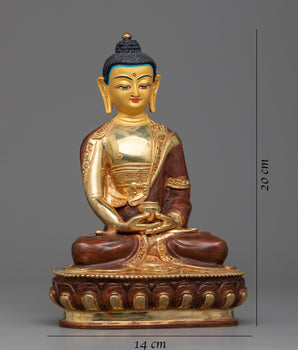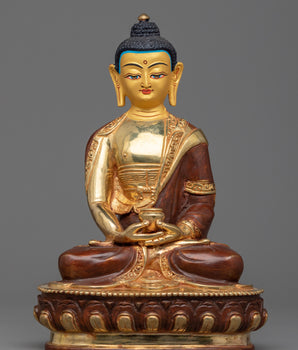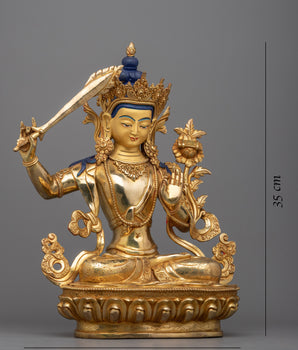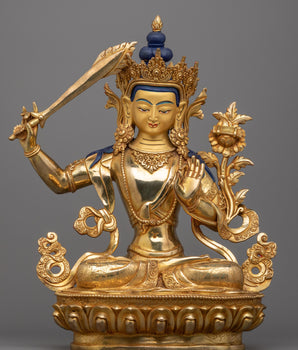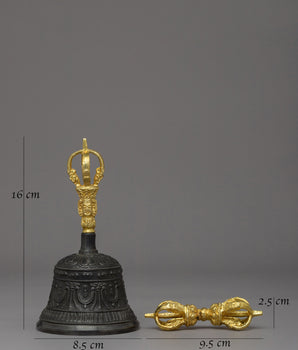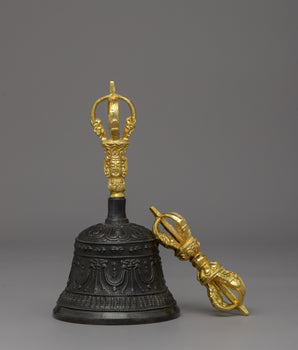Artful Vessels That Bridge Beauty, Ritual, and Home
The monumental Tibetan teapot, one of those rare artifacts. In a world of interior design that often pursues the latest passing trends, there exists a small caliber of décor that not only decorates a room; a dynamic statement piece of decor, this pot is far from simply a decorative piece; also represents stories, spirituality, and symbolism that live on the Himalayan continuum of culture inherited through centuries of history. These are objects that do not whisper fashion; these announce heritage, craftsmanship, and meaning.
Evamratna sits well within the intersection of cultures, meeting contemporary design as a company committed to preserving the sacred art forms of the Himalayas while showcasing these artistic traditions through modern stylings of home décor. This oversized collection of pots is an exceptional reflection of handcrafted copper teapots, hand-hammered and illustrious, often accented with silver plating and Dragon motifs, with gemstone embellishments. This one-of-a-kind artwork possesses the power of story and spirit. It provides a bridge between decorative luxury, meaningful expression, and symbolism, essentially retaining the user and viewer in a narrative-filled exchange through time and space, with altruistic self-expression, enabling the transformation of any environment into something special.
More Than Just a Vessel: The Teapot’s Timeless Charm

Teapots have long been basic components of cultural practice in daily ceremonies, whether through the delicate tradition of a Japanese tea ceremony, the earthy embrace of Chinese Yixing clay brewing, or the fortifying comfort of butter tea in Tibetan culture. Each culture has its meanings, modes of expression, and shapes of vessels, making it a metaphorical representation of some of the purely cultural or ideological qualities.
Traditional teapots are not just functional vessels for preparing tea; they embody much richer aspects, both cultural and historical, of their traditions. The forms, spouts, handles, and patina of any teapot are similarly venues of artistic performance, refinement, cultural heritage, and cultural expression. Collective community knowledge and history about vessels of functional utility are disembodied in the materiality of pots. Often crafted by hand, the deformations of these vessels denote their presence as containers touched by humanness and existence.
In homes, these pouring pots can be filling or decorating shelves, passing through formalities that transition styles and sets until they become obsolete in our quest for modernity. Traditional teapots are essential aspects of our homes, strong-arming a beautiful mobility from the past to the present and, in themselves, imparting a sense of dignity to the modernity of interiors with meaningful spaces. Displaying a collection of traditional pots may not simply be to fill a shelf, but also to seek to maintain a positive connection to the rituals of our own daily lives and to acknowledge objects of history that are filled with story, substance, and depth. As the pervasiveness of fluid engagement through a digital landscape further distances intimacy and thoughtfulness, and promotes hospitality and togetherness, it slows down the normal severity to float through thoughtful moments of gratitude and reflection.
The Cultural Significance of the Teapot

Tea in Tibetan Buddhist tradition is more than just a drink of comfort; it is a sacred practice, a chance to show respect to one another, and an opportunity to connect to the spirit. At the humble monastery on a hillside in the Himalayan range, in the village, and in our homes, the tea ceremony is a time of being mindful, hospitable, and spiritual. The act of serving up tea is dignified and is treated with genuine respect. It is an expression of a pure heart and the beginning of devotion.
Evamratna embodies this centuries-old tradition by producing handcrafted giant teapots that encompass both cultural symbolism and craftsmanship. Crafted from hand-hammered copper with a silver or gold finish and often with inlaid stones, such as turquoise, coral, and lapis, these pouring pots are not intended for brewing tea; they are ceremonial objects and family decorations passed down through generations. They are a vessel for heritage; a carrier of Tibetan Buddhist philosophy - of calm, of sacredness, and storytelling - into contemporary living. In an age when most decor is here to impress, these extraordinary teapots exist to connect - a culture, a philosophy, and something far beyond style.
Design Elements and Symbols
These materials are not appreciated only for their beauty; they have meanings embedded within them. When they come together as a teapot, they become sacred vessels, symbols of hospitality, reverence, and a spiritual connection to the tradition from which they originated.
|
Material Elements |
Meaning and Purpose |
|
Copper |
Traditional base metal represents durability, grounding, and energy flow. Copper is the prescription for objects of ritual more than any other material. |
|
Silver Plating |
Provides an additional layer of spiritual purity and visual shine . In Tibetan mythology, dragons are often assigned power. |
|
Gemstones |
Offer protection, healing, and balance. Each stone carries a specific spiritual meaning. |
|
Dragon Motifs |
Symbolizes protection, wisdom, transformation, and prosperity. Power is often associated with dragons in Tibetan mythology. |
|
Hammered Metal Surface |
Hand-made authenticity; a mark of the craftsman; and a history of careful technique; each dent is a record of time. |
When you add a pot like this to your home, you are not just adding décor; you are welcoming hundreds of years of wisdom, beauty, and peaceful presence into your life.
Traditional Teapots Make Remarkable and Meaningful Home Decor

Traditional teapots, originating from culturally rich areas such as Tibet, Nepal, and the Himalayas, combine visual artistry, cultural stories of their birthplaces, and functional design. Here are some of the reasons why traditional pots can be admired if you have them in your home:
1. Aesthetically Useful Culturally
Traditionally decorated teapots distinguish themselves from more generic pots by their appearance. These pots capture the artistic history of the culture they come from. Perhaps you have a Tibetan copper pot that was hand-forged and shines with bright metallic hues, or a Kashmiri kettle that tells a floral story, or maybe a brightly glazed organic clay pot from the Himalayas that is both asymmetrical and speaks to your experience of the area. Each original pouring vessel gives a unique visual story to create more dimension in your home. These are also original one-of-a-kind decor!
2. Functional Sculpture for Daily Use
While collecting is typically the primary purpose of traditional teapots from Evamratna, a few examples are made to be functional pots. While they have this dual purpose (art and utility), they are exceptionally functional in a unique way. Think about using the same design to pour tea for your guests that was made centuries ago: this is a sensory experience of connecting a designer's history and utility, beauty, and function.
3. Symbol of Sustainability and Slow Living
In a world governed by fast fashion and disposable decor, a handcrafted traditional teapot is the epitome of sustainability and thoughtful living. Such objects are made to last - a family heirloom meant to be cherished through generations. Including these objects in your home is a small way to embrace the slow way of living and be less about timely trends, and embrace intentionality in history and longevity.
4. Flexibility Across Styles
A traditional teapot incorporates easily into any decor style - rustic minimalism to bohemian eclectic to modern industrial - and serves as an anchoring element, allowing for an object of heritage to house a room or be intermixed with a curated collection of objects. Their charm brings home a warmth and character to a modern interior, while also adding authenticity to a stylized space.
5. A Collectible Investment
Traditional teapots have staying power, especially for decor enthusiasts and collectors. Collectors appreciate vessels not just for their craftsmanship but for their scarcity. The ethical sourcing of it from estates or vintage/antique vendors on sites like Evamratna is essential because these pots are not mass-produced and have a story to tell, and even if it has issues, owning a pouring vessel is like owning a piece of living history.
Creating Sacred Space: Integrating Teapots with Intention

In homes today, they foster not simply style, but sanctuary. Evamratna's traditional teapots are not only ornaments but grounding objects of intention to define and enhance intention spaces in the home. A vessel on a meditation table, evocative of calmness and symbolic meaning; on an impeccably minimal altar with crystals; a pot nestled in the centre of a quiet reading nook or aesthetic yet functional space evokes the sacred in every room. It can alter the nature of a room from heading toward chaos and disorder to still space, reflection, and presence. The forms and materials of it complement a space and can allow homemakers not only to create spaces for living, but also spaces for being.
A teapot in intentionally spiritual or mindful interior design is more than art or an object on display; it becomes a mode for emotional and spiritual synchrony and alignment, along with candles, incense, books, and fresh flowers. Reimagined as a sacred space, complex and layered, where beauty can connect with intention and décor can connect with devotion.
Conclusion: More Than Decor—A Legacy of Living Art
A traditional teapot is not solely a collectible item; rather, it is an opening into the function of your space and spirit, including the soft echoes of history, the touch of hand-craftsmen, a slower pace, and a thoughtful approach to culture. Traditional teapots are not simply a functioning, beautiful item; they are connectors of experience, past to future, function to beauty, spirit to daily life. Located in the center of your home, Himalayan pots serve more than simply filling a shelf or completing a vignette. They require stillness, yet inspire a form of decor that is not performative, but participatory. They encourage you to reconnect with meaningful slowness, ritual, and gratitude. In a world where the constant barrage of digital noise and superficial distractions can obliterate the depth of experience, a traditional pot serves as a tangible means of returning to presence, simplicity, and one’s soul and living archives; they represent a way of creating with intentionality and living with thoughtfulness.
Explore Our Traditional Teapot Collection from Evamratna.











